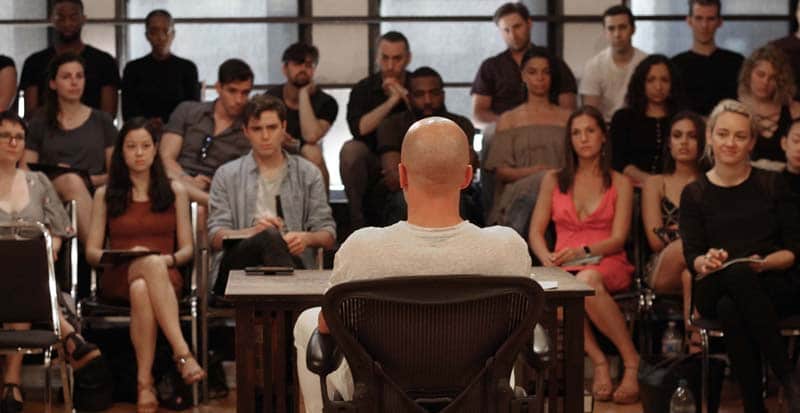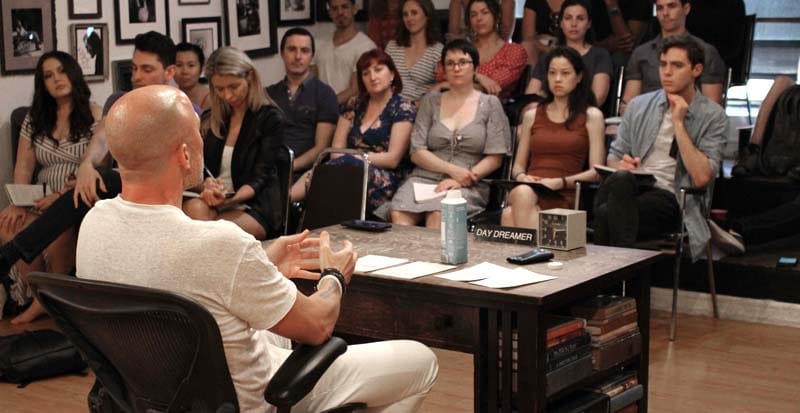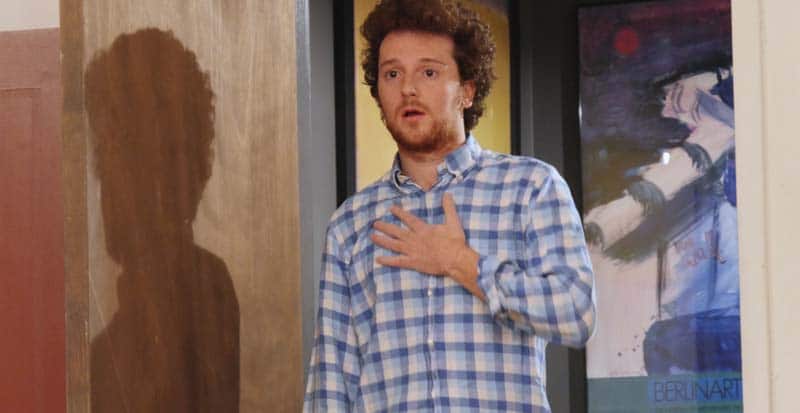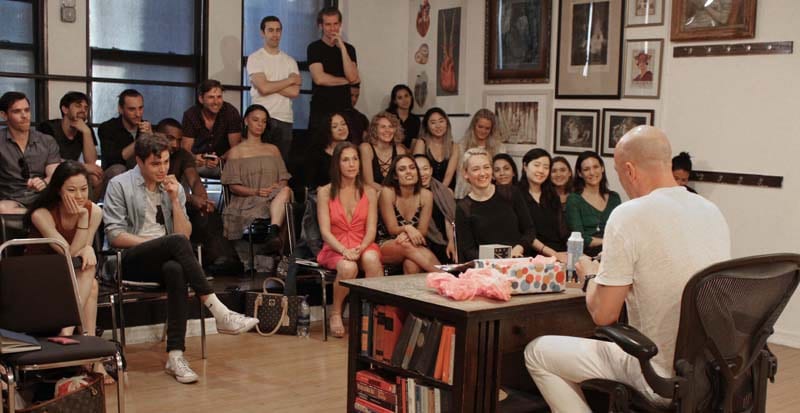
Meisner Technique – Meisner Technique Professional Acting Program – (917) 794-3878
The Meisner Technique was created by Sanford Meisner. Meisner was a professional actor and member of the legendary Group Theater, founded in 1930 by Lee Strasberg, Cheryl Crawford, and Harold Clurman. For the next decade, the Group Theater revolutionized NY theater and laid the groundwork for the robust regional and Off-Broadway theater that is now such an important force in American cultural life. In 1935 Meisner joined the acting faculty of the Neighborhood Playhouse, and over the next sixty years created and refined what is now known as the Meisner Technique, considered by many to be the greatest way to train and ground professional actors with fundamental skill.
Anyone seriously interested in Meisner training has heard about his “repetition exercise”; two people standing across from each other repeating simple sentences, “I like your sweater” “You like my sweater” etc. Unfortunately, because most teachers who claim to teach this work are simply pulling out notes they took while in some summer workshop, they know very little about how the Meisner Technique actually unfolds, and how it should be taught. This simple repetition is actually the seed which sprouts over nine months into an incredibly deep, and sophisticated improvisational exercise that encompasses all of the fundamentals of acting.
If you are interested in learning about the Group Theater and its profound impact on the art of acting, I would recommend two books: The Fervent Years by Harold Clurman and Real Life Drama by Wendy Smith.
The First Year of the Meisner Technique and the Meisner Exercise
Repetition
Meisner understood that the bedrock of acting is the ability to truly listen. Most actors do not possess this skill while working. The attention is on themselves, they wait for their cues so that they can “act”, and are in their head worrying about how they sound and look; incredibly self-conscious. So the Meisner Technique begins with teaching the student actor how to be fully present, fascinated with the other person, curious, open, vulnerable, and really listening. Meisner developed this simple repetition exercise as the very beginning of the training because it accomplishes something essential for the actor: discovering the spontaneous, organic impulse. The repetition removes the need to think about what to say. The student begins to understand how important a personal point of view is to the artist, and the meaning of subtext; not just what is being said to you, but how. This forces the student to tune up their hearing and to be present in each moment. Moments are incredibly important in acting. Any good play or screenplay is nothing more than an unfolding of inevitable moments.
Really good acting then, takes place from unanticipated moment to unanticipated moment, just like life. As an actor, to possess this ability, the capacity to create the flawless illusion of life, is the mark of great skill. In life we miss moments all of the time, we check out or get distracted. In acting, however, if you miss moments, it can derail an entire scene. The other important aspect of this early repetition is that it becomes the tool with which the student begins to take in, developing the slow process of sensitivity training. Students come into class with decades of parenting, socializing and educating. These are all important components of leading a productive, social, and professional life. We have developed a number of ways to defend and protect ourselves from being hurt or feeling vulnerable. If you want to be an actor, however, you must possess the capacity for vulnerability. So in essence, the actor in training must work to return them to the playful and curious child. Picasso said, “All children are artists. The problem is how to remain an artist once you grow up.” This is not achieved quickly, and Meisner understood that. These first few weeks of repetition begin the slow process of chiseling away at these defenses, to allow the student’s empathy and humanity to surface.

Meisner Technique Training at Maggie Flanigan Studio in New York, NY
The Independent Activity
Constantin Stanislavski is considered the father of modern acting. In his work with the Moscow Art Theater in the 1920’s and 1930’s, he introduced the idea of organic acting, truly living and breathing the part. Before Stanislavski, acting was very presentational, melodramatic, and stylized. Meisner based his acting classes in NYC on this understanding; living truthfully in the imaginary world. But how does one accomplish this? Meisner knew that to live truthfully, an actor must do truthfully. This insight led him to his working definition of the art form; acting is the ability to do truthfully under an imaginary circumstance. Meisner training, at its essence then, is to hone the actor’s ability to truthfully do. So the next phase in Meisner training establishes the student actor’s ability to achieve this.
The introduction of the Independent Activity begins to teach the actor how to craft. Most actor’s in this country, especially untrained ones, indicate behavior. They pretend. So Meisner’s first version of the Independent Activity comprises a number of elements that start developing the student’s ability to truthfully do what they say they are doing. The requirements of the Independent Activity; a very difficult object, a standard of perfection, having everything you would need to achieve truthfully, a simple reason why, and a time element, begin to instill this skill. It also requires the student to develop Actor’s Faith; the ability to accept as true what you have given yourself. These elements are ultimately imaginary, and yet the actor must be able to respond to them as if they are real. In life, if you were to be mugged, and have a gun pulled on you, a number of things may happen. You might become terrified, you might start to shake, your heart pounding a mile a minute, perhaps even piss yourself. It’s only a well-trained actor when a prop gun has been pointed at them on the 22nd take will she or he be able to respond “as if” it’s truly happening. The better an actor crafts, the more believable their behavior will be. Actor’s Faith is very much like an inner bullshit detector that should go off that says, “wait, this isn’t truthful”. An actor who has developed an inviolate sense of truth has a grounded, truthful reality.
Untrained actors, because they have no concrete way of working, are incredibly general, and tend to complicate and confuse themselves. The ability of an actor to take rich, sophisticated text and break it down into simple, specific and personal crafting is one major component of separating the amateur from the artist. Meisner training makes this ability instinctive and second nature. Once students start crafting simply and truthfully, Meisner’s Technique then starts to teach the actor how to craft personally, from the imagination. If you wish to ever possess the ability to take on major roles, one must be capable of identifying deeply with the character, the issues, and the relationships that shape his or her behavior. Meisner knew that if an actor did not know why they came on stage or into the frame, their work would not be good. The reason why, what compels an actor (ultimately the character) to do what they are doing, must be deeply personal. Also, with the Independent Activity, the Meisner Technique teaches the student how to begin to harness their ability to daydream to the art of crafting. When the Independent Activity, at this beginning stage is crafted tightly, the actor will truly be out of their head. Their placement of concentration will be off of themselves, onto what they are doing, and will accomplish something extremely important: they will begin to create vivid, spontaneous, organic, truthful behavior in the imaginary world.

18-month Meisner Acting Program – Charlie Sandlan – (917) 794-3878
The Door Work
The Meisner Technique is always executed in pairs. So what is the other actor doing as their partner is engaged with their independent activity? As the Meisner Exercise continues to evolve, the Independent Activity ultimately takes place in that student’s “apartment”, with the other student eventually coming to their door. The “door work” as it is commonly known, continues to develop the actor’s ability to listen, answer and respond personally. The brilliance of what Meisner created, is that each side of the exercise (door work and independent activity), strengthens a different yet essential part of an actor’s instrument. As the Independent Activity deepens, the behavior coming at the other person will become sharper, and more intense. This forces both actors to become comfortable with conflict (a great part of what acting is, along with intimacy), capable of standing up for themselves, and courageous enough to respond in the moment to how they truly feel. (Don’t assume, however, that this is merely a conflict exercise. For many teachers who don’t fully understand Meisner’s work, its thought of as simply two actors getting into a fight. But in fact, over the nine months of Meisner training, what actor’s live through with each exercise is truly a kaleidoscope of the human condition.) This first phase of the work should take about eight weeks, at which time the students are ready for their first round scenes.
First Round Scenes
When Meisner created his professional actor training, he knew ultimately, that these skills would be of no value if they could not be transferred to scenes. The text is after all, the actor’s playground. The first year of the Meisner Technique, if correctly taught, incorporates three rounds of scene work. Each round challenging the actor to transfer all they have learned up to this point in the Meisner exercise, to scenes.
Whether one has acted before or not, everyone brings with them ideas about what acting is. Misconceptions based on the film, TV, and theater that one has consumed. This is even more so if a student has worked in college or professionally, or has been subjected to bad teaching. Bad habits form. The goal of the first round of scenes is to begin to rid the actor of these habits: line readings, adjusting to the text, waiting for their cues, not responding to subtext, or manipulating their emotional life in order to fit what they believe the results should be. Those are all the markings of an untrained amateur. First Year student actors do not read the play, nor at any point are the character, motivation, or script analysis considered. Students simply memorize their lines without inflection and learn to improvise their way through the scene. First Year is about instincts, impulses, and spontaneity. Untrained actors do not have these qualities. Because they have no craft, they will memorize how they want to “perform” their lines, which leads to conventional, cookie-cutter, indicated garbage. That’s why, when a casting director sees 200 actors for a part, 180 will typically do the exact same thing. A true artist, however, prizes their sense of truth, their uniqueness, and their spontaneity. Meisner understood that this requires freedom and instincts, a priceless part of an actor’s skill set. These first round scenes challenge the actor to work in the same way as they have with the exercise; out of their heads, spontaneous, and personally responsive from unanticipated moment to unanticipated moment, regardless if it is right for the scene or not. Students also learn how to identify, and talk about the previous circumstance of the scene, an important first question in an actor’s craft.
Emotional Preparation
Emotional Preparation is what an actor does off-stage in order to emotionally relate to the previous circumstance of a scene. This is self-induced emotion and is a very substantial and sensitive area in acting. Meisner’s approach to this important fundamental skill is the biggest difference, among many, to Lee Strasberg’s Method, which relies on sense memory and emotional recall. Meisner believed that the imagination was a far more fertile and creative place from which to create, and did not agree that going into your literal past was either healthy or necessary to the craft of acting. The majority of amateur actors have big misconceptions about emotion in acting. Most think that the quantity of an actor’s emotional life indicates talent. You see it in bad actor’s all the time: pushed or indicated emotion, often riddled with physical and vocal tension, and usually nothing deeper than various levels of superficial anger. How many times have you seen actors on stage merely angry and yelling at one another? Anger is superficial (that’s not to say that sometimes it is absolutely appropriate), and very rarely illuminates anything about the deeper human condition. The quality and fluidity of an actor’s inner life is the mark of a true professional. This requires a dedication to not just acting training but to physical and vocal training as well. Really exceptional actors have a supple and pliable instrument capable of processing rich experience. That is why Voice and Movement are critical companions to Meisner Training and should be a core component to any serious two-year professional training program.

Student Meisner technique Training – At the Door
Having an understanding of Freudian psychology and anatomy, Meisner knew that the nervous system does not know the difference between fantasy and reality. We daydream and fantasize naturally in life, very vividly and graphically about things that have real meaning to us. Our daydreams are born out of our primitive unconscious, the creative life force of the artist, and produce physical and emotional responses. They are healthy ventilators, giving us the ability to reshape reality in a way that is more favorable to the ego. The obvious example, which needs no explanation, is the sexual daydream. The Meisner Technique teaches the actor how to harness this natural human ability to daydream offstage/off-camera, triggering them at will in order to bring themselves to a rich, organic emotional life. The student actor then becomes adept at attaching this emotion to the previous circumstance of the scene and then walk on-stage, fully connected. As the actor gains experience and eases with emotional preparation, they work to become more precise with their inner life, so that they can truly illuminate the previous circumstance. For example, there is a big difference that comes from the joy of booking your first major role, the joy of a marriage proposal, or the joy that comes from learning that your mother’s cancer is in full remission. A truly well trained Meisner actor has the insight and ability to distinguish and illuminate all three.
The Domestic Exercise
The next step then in the Meisner Technique, is the addition of emotional preparation to the exercise. At this point in the actor training, the repetition has been removed, a tool no longer needed, as the actors are now capable of responding spontaneously from moment to moment for how they feel. Meisner considered the early repetition to be like training wheels, which, when eventually unnecessary, are taken away. Also, the Independent Activity has been altered in order to allow the actors to begin exploring the wide range of their temperament and imagination, challenging the actor to work deeply from their rage, joy, silliness, sensuality, fear, grief, jealousy, embarrassment, humiliation, and shame, while still developing the ability to craft. In addition, Meisner changes the form of his technique to the Domestic Exercise. The actors now live together, one actor at home engaged in an independent activity, and the other actor coming home after an emotional preparation and rich connection to an imaginary previous circumstance.
The ability of an actor to be fully alive emotionally, still listen, respond personally, and do truthfully, is incredibly difficult and takes many months to accomplish. The students will learn that emotion should ebb and flow from moment to moment. Bad actors will try to hold onto their emotion because it feels good, and makes them think that they are doing something illuminating. Or, if they even feel anything at all, will stew and wallow in their emotional swamp making any empathy from the audience impossible. Most are typically self-indulgent and manipulative of what happens to them emotionally. Really good Meisner training continually emphasizes the understanding that the other person is more important, always. Students learn that fluidity of emotion is the mark of a good actor. Once students are comfortable emotionally preparing and coming home, Meisner’s Technique challenges the actor to master yet another fundamental skill.
Emotional Preparation and the Door
The form of Meisner’s Exercise changes again, putting the actor back at the door. The student with the Independent Activity now lives alone, and the other actor crafts a simple yet deeply personal previous circumstance, emotionally prepares, and comes to their friend’s door and knocks. The actor also learns how to craft an objective, a vital fundamental of acting, while learning to not sacrifice their sense of truth pursuing it. The student must learn to be fully alive and be able to stand still, fully present and vulnerable, while continually listening, answering and responding from moment to moment.
Also by this point, the Meisner Technique has added another crucial fundamental skill to the Independent activity, implanted meaning. An actor’s ability to implant meanings to beats and moments throughout a script is part of a professional’s basic skill set. If for example, on the middle of page two, the doorbell rings and the police arrive to tell me my son has been killed in a car accident, I know as the actor that I must have very specific and vivid behavior for that moment. It can’t be anticipated or allowed to influence any previous behavior. It happens in the moment, spontaneously and unexpectedly, and in this instance tragically – just like it would in life. That is implanted meaning, and it occurs hundreds and hundreds of times to varying degrees with a major part. Meisner adds Expectations to the crafting of the Independent Activity. When one actor is coming to the other’s door, they will knock. The actor with the Independent Activity knows this is going to happen, no different then if he/she is reading a script; at this point, there will be a knock at my door. The student actor learns to do homework on the meaning of the knock. Who or what is coming to the door, and what is the emotional meaning to them. They learn how to start to implant homework, leave themselves alone, and trust that the behavior will be there. Ultimately, an actor’s entire performance is programmed within them, and like Pavlov’s dog, they let the moments and the other actor(s) extrovert their work. That is another vivid separation between the amateur and the professional.
Second Round Scenes
Students at this stage in their professional actor training are now ready to apply emotional preparation to scenes while continuing their ability to improvise personally and respond spontaneously. The actors again memorize by rote, do not read the play, and do not concern themselves with character or interpretation. Students are challenged to identify in a simple way the previous circumstance of the scene, and answer the second important question in crafting, how do I feel about it? This is the next step in an actor’s ability to personally identify with the issues and circumstances of the scene.
The Acting Relationship and Shared Circumstance
By this point, the class is nearly six months into their first year Meisner training and are ready for the most exciting and gratifying stage of the work. The actors now learn how to substantiate the acting relationship. Up to this point, both actor’s have had a general friendship, nothing more. So how do you take the given relationship of the text (husband, wife, brother, sister, lover, best friend, etc.) and craft a personal relationship that will ultimately be illuminated in behavior? It is a vital fundamental of acting, and the third question an actor must pin down in their crafting. Meisner returns to the exercise as it was before second scenes; one actor at home alone with an independent activity and the other actor coming to the door with an emotional preparation. The first step is to introduce a simple and imaginary one-word point of view that the person at home has towards their friend coming to the door: hypocrite, liar, flirt, gossip, troublemaker, etc. Both actors are now learning how to respond to, and interpret moments, from this point of view.
Once this has become established, the Meisner Technique introduces Shared Circumstances. The vast majority of acting involves shared circumstance; a personal relationship, something happens between them, because of which both characters have a strong emotional point of view and an objective that arises out of this event. Any competent actor must be able to craft this in a simple, personal, and specific way. Now the Meisner Technique is at its most sophisticated. This stage of the work has two forms of the exercise. A good month is spent with one actor coming to the door and another month living together. Meisner understood that this is how his students could live through the widest array of human relationships. Each class, the actors are living through profound, life-altering circumstances, becoming consistent in the ability to create organic, vivid, human behavior that illuminates both circumstance and relationship. It is a true workout of the human heart, a brilliant exercise that encompasses all of the fundamentals of acting, creating an actor who is truthful, vivid, and courageously vulnerable; everything we go to the movies and theater to witness.
Third Round Scenes
The Meisner Technique is now into its ninth month, and the actors are ready to take the entire year of learning and apply it to their final scenes. Again, not reading the play, memorizing by rote, and eliminating any concern for interpretation, the students can now find their own personal emotional line of the scene, and have the capacity to craft a previous circumstance, emotionally prepare off-stage, craft an acting relationship, and identify their objective in the scene. They then rely on the essential fundamentals of good acting: really listening, responding personally, putting your concentration on the other person or what you are doing, going from unanticipated moment to unanticipated moment, working from your spontaneous impulses, in perfect adjustment to the other actor, freed finally from the need to adjust to the text, creating vivid, human behavior which comes from the confidence of excellent professional actor training.

Meisner Technique Acting Program – Charlie Sandlan at the Maggie Flanigan Studio – (917) 794-3878
The Meisner Acting Foundation
When I describe this work to prospective students interviewing with me, I use the analogy of building a house. The first year of the Meisner Technique is pouring the concrete and laying the foundation. The goal of the first year is to create a truthful acting instrument, an actor who can consistently create organic behavior, with the fundamentals of the art form second nature. Once that has been instilled, the student is then ready for the more difficult work of Second Year. This is the building of the house. Meisner training in Second Year focuses on character. How do you read a script like a professional actor? How do you approach a professional rehearsal or audition? How do you break a script down into beats, actions, and line intentions? What are the tools that you can learn to interpret material? How do you begin to approach the lead roles of the art form, the work of Tennessee Williams, Arthur Miller, Edward Albee, Susan Lori-Parks, Lynn Nottage, Martin McDonough, David Mamet, Annie Baker, Branden Jacobs-Jenkins to name just a few of the great past and current playwrights? Elia Kazan (a Group Theater member) said famously that a therapist turns behavior into psychology, and the actor turns psychology into behavior. This is the new challenge of Second Year work.
It is a testament to Sandy Meisner and his half century of acting classes in NYC, and to the technique, he created, that it is still being taught in various forms throughout the world. That said, there are only a handful of truly precise and accurate teachers of the Meisner Technique in the United States. The Meisner Technique in its entirety is not six weeks, six months, or one year. Meisner’s full professional actor training takes two years to teach. When searching for acting studios in NYC or elsewhere, more specifically a professional Meisner training program, make sure to do due diligence. Any serious and reputable Meisner teacher should not only be trained in the technique as an actor with years of professional experience but should also have been mentored and groomed as a Meisner teacher by a true master who has an established reputation for accurately teaching the work. That’s when you will know that you have found the right place to become a true Meisner trained actor.
Learn More About the Meisner Technique Program
Want to find out more about the Meisner technique, then visit The Maggie Flanigan Studio website https://www.maggieflaniganstudio.com Click here to learn more about the acting classes and acting programs at the studio.



